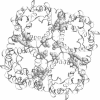SDPpred: a tool for prediction of amino acid residues that determine differences in functional specificity of homologous proteins
- PMID: 15215423
- PMCID: PMC441529
- DOI: 10.1093/nar/gkh391
SDPpred: a tool for prediction of amino acid residues that determine differences in functional specificity of homologous proteins
Abstract
SDPpred (Specificity Determining Position prediction) is a tool for prediction of residues in protein sequences that determine the proteins' functional specificity. It is designed for analysis of protein families whose members have biochemically similar but not identical interaction partners (e.g. different substrates for a family of transporters). SDPpred predicts residues that could be responsible for the proteins' choice of their correct interaction partners. The input of SDPpred is a multiple alignment of a protein family divided into a number of specificity groups, within which the interaction partner is believed to be the same. SDPpred does not require information about the secondary or three-dimensional structure of proteins. It produces a set of the alignment positions (specificity determining positions) that determine differences in functional specificity. SDPpred is available at http://math.genebee.msu.ru/~psn/.
Figures



References
-
- Lichtarge O., Bourne,H,R. and Cohen,F,E. (1996) An evolutionary trace method defines binding surfaces common to protein families. J. Mol. Biol., 257, 342–358. - PubMed
-
- Livingstone C. and Barton,G. (1993). Protein sequence alignments: a strategy for the hierarchical analysis of residue conservation. Comput. Appl. Biosci., 9, 745–756. - PubMed
-
- Casari G., Sander,C. and Valencia,A. (1995). A method to predict functional residues in proteins. Nat. Struct. Biol., 2, 171–178. - PubMed
-
- Gaucher E.A., Gu,X., Miyamoto,M.M. and Benner,S.A. (2002). Predicting functional divergence in protein evolution by site-specific rate shifts. Trends Biochem. Sci., 27, 315–321. - PubMed

